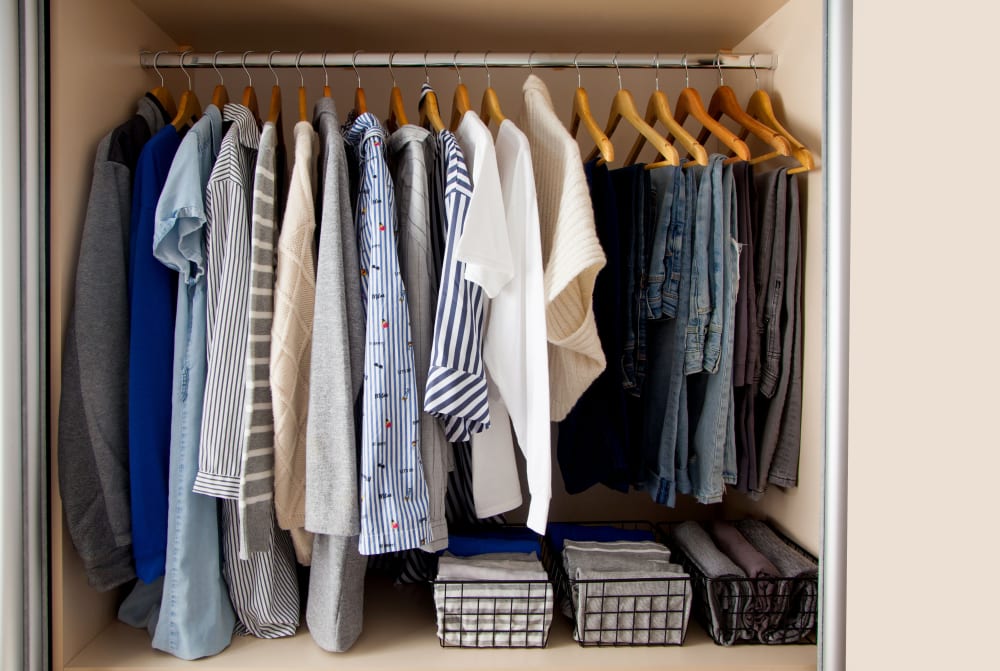It’s spring time! Emerging from the darkness of winter people often start to consider doing a spring clean of their wardrobe.
We have all been there, opening your wardrobe every day and sifting through clothes that you haven’t worn for 6 months or more to locate that beloved pair of jeans. And then, inevitably, you get the urge to have a clear out. Your bedroom becomes a sea of piles and you realise you had a lot more than you thought.
Spring cleaning your wardrobe is important for a lot of us to keep organised and make sure we aren’t taking up space in our lives with things we no longer wear. It can become a little overwhelming, and the urge to chuck it all in a bag and get it out of the house can seem tempting. However, don’t succumb to this temptation! It is so important that we take a considered and conscious approach on our clear outs, to minimise waste and maximise the use of our clothes.

How to Sustainably Spring Clean
Step One: Slow and Steady!
Take your time! Allow yourself time to think about the best next step for your clothes. Rather than just filling a bin bag and sending it off to landfill. Split up the cleaning schedule by sections, so you don’t end up with clean out fatigue by the end. Ever feel like you throw out so much more towards the end of your clean compared to when you first start?
You might even find things you forgot about during your spring clean- try things on and give yourself time to rediscover items you might have forgotten about!
Rachel Fortune- ‘I guarantee that you will find some treasures hidden at the back of your wardrobe that you would have completely forgotten about, yet, when you put them on, you miss how great they make you feel!
Read more about our chat with sustainable stylist Rachel Fortune, with some top tips to start your own Wardrobe Restyle!
Step Two: Up-cycling
Is there anything that you can do to make the garment have a use for you again? You could make small alterations to make the garment fit your body better. Or even make it into something completely different. Up-cycling is when you take something that doesn’t fit, is old, worn out or damaged and transform it into something else. The beauty of it is that you don’t have to have experience in making clothes or even sewing; it could be an amazing opportunity to learn something new. We spoke to Lucy to get an insight into her alteration and up-cycling journey.
Up-cycling Question Time with Made By Lucy- @clothes_upcycling
- What inspired you to start up-cycling clothes?
“During lockdown, I was bored and looking through all my clothes. So many didn’t fit me right or showed my bra straps or dresses were too long etc, and it seemed a shame to get rid of them! So I started learning to alter clothes to make them fit better, and then once I had practice with that I moved onto upcycling and changing them, like turning a dress into a bodysuit”
- Did you have any experience of sewing / altering clothes before you started up-cycling your clothes?
“I’ve always been interested in sewing but I used to literally do the basics, like sewing on a button. I never really started doing much sewing until a year ago though, and I’ve never had any experience of up-cycling clothes”
- Do you have any advice for someone who’s interested in up-cycling but not really knowing where to start?
“I think in terms of starting sewing and up-cycling, YouTube videos are one of the best learning tools, they’re so in depth. I think it’s easiest to start learning to alter clothes first, because then you know the basics before up-cycling them. Practising on old fabrics first is a huge help too!”

Step 3: Second Hand Marketplaces
If you decide up-cycling isn’t for you, maybe someone else would like the opportunity to own your garment. There are multiple options for selling your second hand items such as Depop, which promotes the idea of circular fashion. The key premise for circular fashion is to keep a garment or material in use for the longest time possible, to extend its value and useful life, rather than sending it to landfill. An example of this is selling your second hand clothes, which extends its lifespan. You could even up-cycle your garment and then sell it on a second hand site.
Step 4: Donate to Charity Shops
Another option is giving your clothes to charity shops. This can be a good way to extend the lifespan of your clothing. However, charity shops can’t sell everything that is donated and often end up with a surplus or with things that aren’t fit to be sold on. Unfortunately, there is a proportion of clothes that they won’t be able to sell. In a study done between June 2018 and June 2019, 85 UK Charity shops sent 810 tonnes of donated items to landfill. Being conscious about what you’re sending to a charity shop is really important, making sure the item is clean and in wearable condition can mean the difference between it being sold on or sent to landfill.
Step 5: Donate to Local Organisations
You could consider donating items to local organisations and associations that could benefit from clothes you no longer need! For example, homeless shelters/children’s homes/ nursing homes or women refuges. Not only is it a great way to help your local community but once again, it extends the lifespan of the clothes! Which is much better than them heading off to landfill.
Step 6: Compost!?
Some garments which are made of pure natural fibres can even be composted! So if you find any pure wool, cotton, silk, linen, hemp or ramie garments in your closet that you no longer want, try putting them in your compost bin to biodegrade!
Read more about some common fabric compositions, including the natural fibres that you’re likely to find in your wardrobe.
After your Spring Clean
Overall, there are so many ways that you can sustainably clear out your wardrobe. But the most important thing is that you’re conscious and considerate when making the decision about what to do next with your unwanted clothes. There are so many options, whether you want to up-cycle it for yourself, or for someone else; sell it on a second hand marketplace; give it to a charity shop; donate it to a local organisation or even compost it!
The biggest thing to remember is that the considerate approach is the best- not every single garment that you want to get rid of will be appropriate for one method. Take your time and figure out what the best next step is for each piece of clothing.
When you are ready to add a few more additional pieces, be creative and consider innovative ways to achieve your personal style! Consider buying sustainably from brands that produce with people and environment in mind, such as those that we partner with at Curobe! Another great option is to look at some of the options mentioned above, like second hand marketplaces, charity shops and up-cycled options.
Wishing you a very happy spring and happy spring cleaning!

Like what you just read? Share it on:

